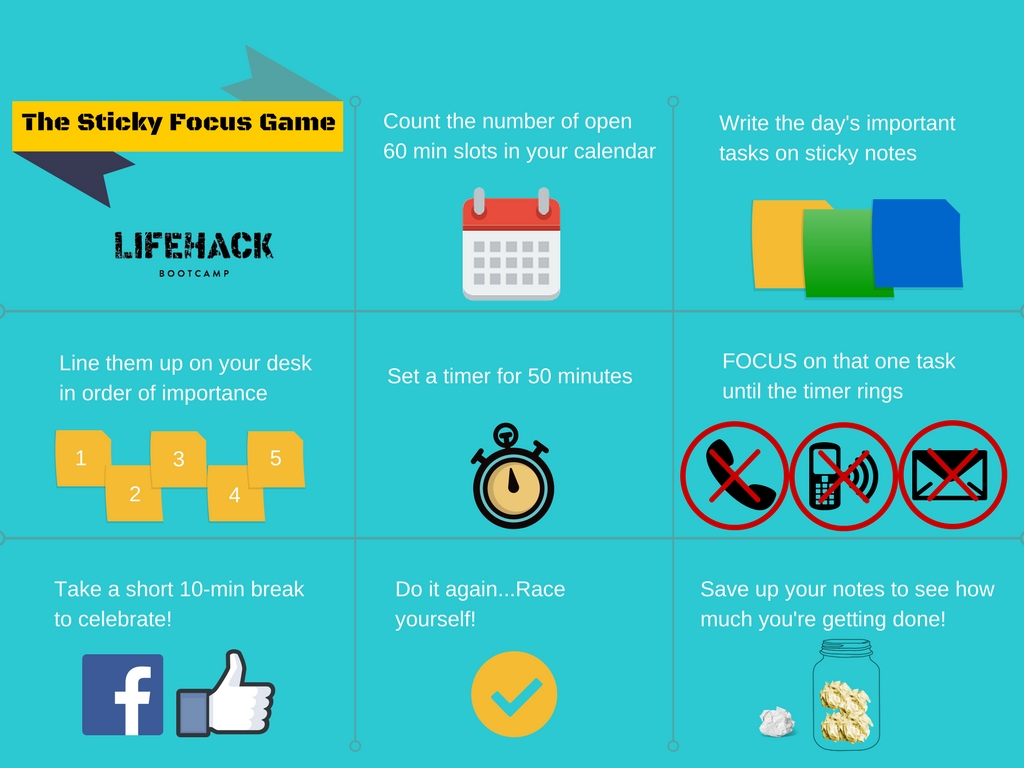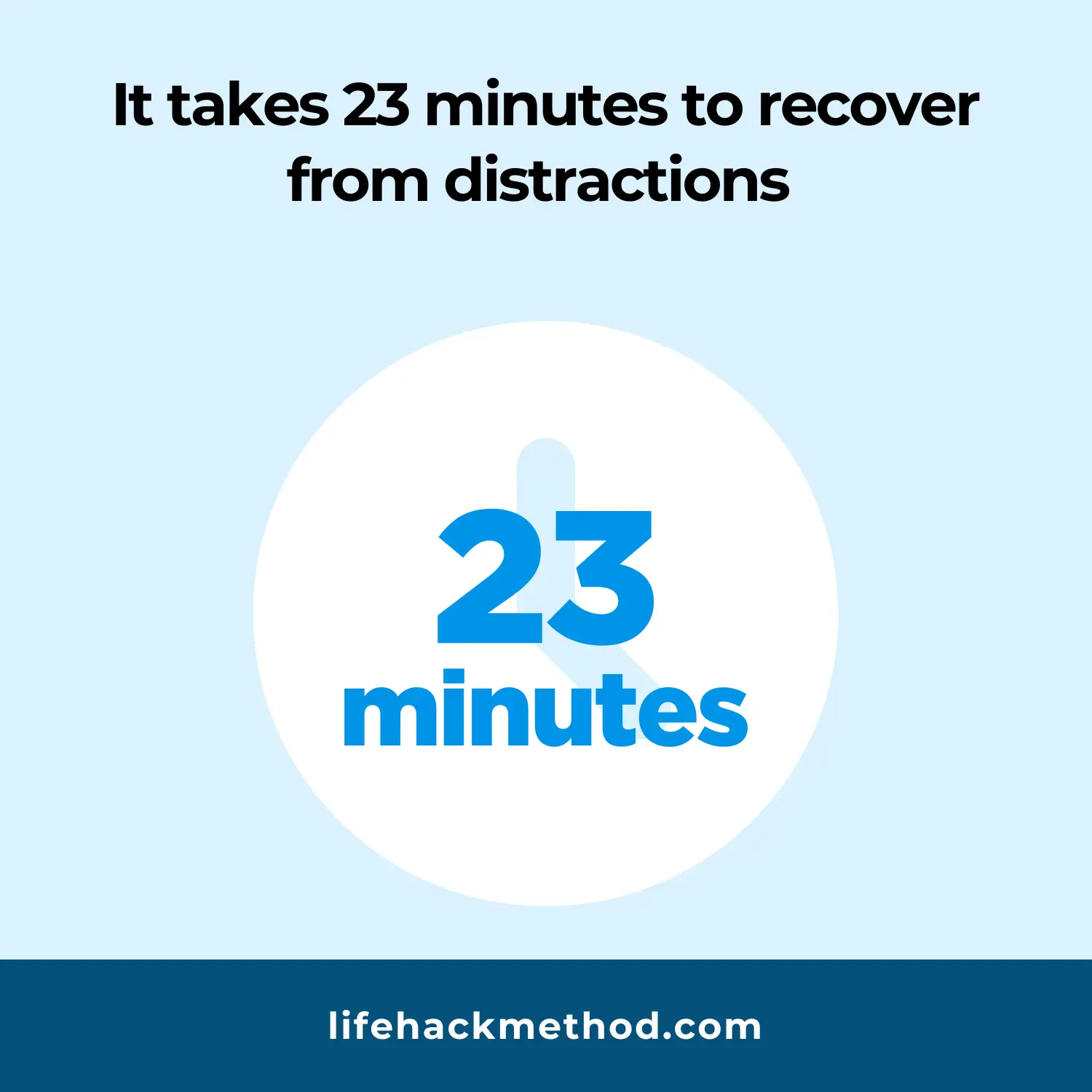How do you stay productive while working from home?
At Lifehack Method, we’ve always had a work-from-home culture. Our whole team is located remotely across the USA, Colombia, Asia, Australia and Europe. In fact, Carey and I haven’t even met many of our team members in person!
So, we have a wealth of knowledge to share about how to be productive working from home.
And that’s what we’re going to show you in this step-by-step guide.
Let’s dive in…
Quick overview:
- Get the foundations in order, including boundaries with people in your household
- Create structures for your work (including routines and planning ahead)
- Don’t wear PJs and create a dedicated workspace
1. Find a designated workspace
According to research by Stanford University, productivity goes down 10% to 20% when working from home.
At the same time, it can be done.
For example, Carey and I have built a fully remote business, Lifehack Method, while living and working in different countries. Our team is fully remote – and yet, we have a highly productive work environment (our business is, after all, all about productivity).
So how can you become more productive working from home?
The first question to ask yourself is, “How can I create a defined workspace at home?”
Many people tell me they don’t have a dedicated office at home… but they have a walk-in closet, a pantry, or even a car parked in the driveway.
These are all potential workspaces!
A designated area is necessary for focus and productivity – and you need one to be productive working from home.
The space where you work will become associated with work in your mind – so give yourself the space to only work in this designated area (reserve your bed for sleep and your couch for relaxation!)
If you can’t have a space to yourself, create “sensory isolation.”
In other words, you need to take control of your eyes and ears. Face yourself away from distractions by looking out the window or even into a corner, and go overkill on sound blocking. (I use earplugs AND over-the-ear noise-canceling headphones.)
This solves the problem of you distracting yourself, but not the problem of THEM distracting you!
So, create a STOP SIGN sign three times larger than you think it needs to be and put it as close to you as possible. In fact, tape it to your back – it’s silly but effective!


2. Have a “start work” and “finish work” routine
Imagine opening your computer every day and knowing you have time to complete your most important tasks and push off the others.
You could crush your work day and end it feeling accomplished and satisfied! That’s the power of the Start Work Routine.
It’s a 10– to 15-minute routine that includes a reward and is designed to help you refocus on what’s most important.

Here’s an example of a five-step Start Work Routine that works for some of our advanced clients:
Cue: “I’m opening my computer”
- Check your tasks and prioritize them. (2 minutes)
- Check your calendar to see how many work slots you have. (2 minutes)
- Assign your critical tasks to those slots. (10 minutes)
- Update your team or boss when necessary. (2 minutes)
- Clear your inbox. (4 minutes)
Reward: Check the news for 10 minutes.
At the end of the workday, you need to be able to DISENGAGE from your work and let your mind and body recover from the day.
You get stuck in a vicious cycle where you “become” your work when you don’t. Ironically, your work suffers as a result!
A Finish Work Routine will help you celebrate what you accomplished, mourn what you didn’t, and create a game plan for tomorrow. Psychological studies have shown that this simple ritual allows you to disengage from work because you know you have a place to tackle it tomorrow.

Here’s an example of a 20-minute Finish Work Routine:
Cue: 5:30 p.m. alarm
- Reflect on what you accomplished and what needs improvement for tomorrow. (5 minutes)
- Plan your tasks for tomorrow. (5 minutes)
- Quickly handle any urgent emails. (5 minutes)
- Tidy up your desk or office. (5 minutes)
Reward: Shutting your laptop and saying, “I’m done!”
Check out all of our core routines here.
3. Pre-plan religiously
Pre-planning your week in hour-by-hour detail is one of the best ways to claim control over your time and be productive working from home.
I advise my clients to create an hour-by-hour time budget for their week, where they can allocate all 168 hours in advance.
This might sound intense, but it will be a lifesaver if you face massive distractions.
Here’s how to do it in 5 simple steps:
- Reflect on last week.
- Set a weekly goal.
- Review your calendar, reschedule as needed, and schedule essential activities.
- Update your to-do list.
- Create time slots for specific tasks in your calendar.
I’ll tell you more about the step-by-step process I use to pre-plan my week in this free PDF guide.
4. Have office hours
Establishing office hours is crucial if you want to be productive working from home because they allow you to create a clear boundary between your professional responsibilities and personal life.
For example, if you’re most productive in the morning, focus on more challenging tasks before switching to lower-energy activities like emails and administrative tasks around midday.
But it only works if you create a schedule that works for you. Figure out when you’re most productive and schedule your work within those hours.
Once you have them, stick to them! Consistency and routine are key to being productive working from home, and office hours will give you the structure you need to manage your time efficiently and stay on track.

5. Use the 5-minute rule
Knowing how to be productive working from home without structure to your day or normal workplace pressures can be difficult.
I have a mental game trick to help you get started when no one is breathing down your neck. It’s called Breaking The Seal.
Set a timer for 5 minutes and tell yourself that all you need to do is work on that task or project until the timer rings.
Getting started is the hardest part of any task, and breaking the seal with the 5-minute timer helps dispel any fear or mental resistance you may have.

Most of the time, you’ll find that you’re “into it” once the 5 minutes are up, and you’ll actually want to keep working. You may even find the task is easier than you thought it would be!
Other times, you’ll find that you have a much better handle on tackling the problem, and you’ve gained a sense of clarity around what to do when it’s time to really get it done.
6. Use timed work blocks
You could be voted Best Multitasker Ever and still struggle with multitasking.
Because in reality, no one is actually good at multitasking. It’s not even a real thing! What masquerades as multitasking is actually something called rapid task switching.
So every time you stop working to feed the dog, talk to a family member, or watch an episode of your favorite TV show… you’re forcing your brain to switch gears.
The result is a slow, tired, does-not-compute brain that has to restart its operating system repeatedly.
To be productive working from home, try timed work blocks with our Sticky Focus Game!
It’s one of our master hacks for turbocharging productivity. It makes work fun, enables faster work, and keeps you focused on the task at hand.
Here’s how to play the game:
- Count the number of open 60-minute slots in your calendar for the day
- Write the day’s essential tasks on sticky notes
- Line them up on your desk in order of importance
- Set a timer for 50 minutes
- Focus on that ONE task until the timer rings – no Facebook, no texting!
- Take a 10-minute break to celebrate – and really REWARD yourself during this time! (Pro tip: You can use your home-based distractions as a reward. Play with the dog! Have a dance party with the kids!)
- Repeat this process and race yourself.
Click here to download our Sticky Focus Game cheat sheet.

7. Take breaks
Most people assume they can only be productive working from home if they stay glued to their computers for hours, but that’s not true.
In fact, taking breaks actually boosts performance and keeps you motivated. Otherwise, we feel stressed out or tired, which impacts our ability to be productive working from home.
Here are the most effective breaks:
- Creative (Daydreaming, setting a goal, learning)
- Movement (Exercising, changing where you’re working, going outside)
- Nourishment (Meditating, having a healthy snack, taking a nap)
- Socializing (Talking to a friend or family member)
8. Communicate with your family
Other people can be severely damaging to your productivity.
I get asked about this flavor of distraction a lot, typically along the lines of, “I need help with setting boundaries with my girlfriend. She and I work from home together, but she’s a talker who likes to “visit” me in my office. How can I keep her away without being offensive?”
Here’s how to handle it: Communicate upfront what will happen and why.
Write a clear communication policy to set expectations about your availability and explain why it’s important to adhere to it!
Enroll them in the whole story and get them on your side by including generous periods where you will be fully available to their needs.
People don’t need as much of your time as you think they do – they want their emotional needs met. So ask yourself what emotional need (likely unspoken) your family members or housemate lacks, and do your best to meet it.
When people have their needs met, they can disconnect.

9. Communicate with your team
Working from home means that you have severely limited opportunities to talk with coworkers, which can be great for your productivity!
But to be productive working from home, you have to master the art of asynchronous communication. Don’t schedule meetings for every little thing or overload your Slack channel or email.
Instead, take this opportunity to uplevel your communication with tools like screencasting and a task manager. Screencasting is an extremely dense form of communication and takes a fraction of the time of a meeting or crafting an email.
You should also batch communication.
You may experience an influx of messages and emails from colleagues doing their best to push work forward. However, this becomes exhausting for you and chips away at the time you actually have to get work done.
Batching communications together is critical to maintaining focus while communicating with your team.
Schedule times when you will be on your email and messenger, and tell your team members how to reach you if something is urgent.
10. Exercise
You’ll notice a huge decrease in your step count when you start working from home! There isn’t much movement in your day when you’re trying to be productive working from home… and those walks to the fridge aren’t sufficient 😉
Movement enhances cognitive function and improves employee focus, information processing, and alertness.
It also boosts energy levels and mood, which are key if you want to be productive working from home.
So take time to get out of your seat! You might burn out otherwise.
It’s as easy as scheduling time in your calendar to get up, stretch, take a walk, do some yoga, or even practice deep breathing or meditation.
It might take some initial willpower to break the cycle but trust me, once you get into a routine, these quick movement missions will become second nature.
11. Don’t wear your PJs
When you don’t have environmental cues that tell your brain it’s time to work, you have to find ways to trick your body into thinking it’s time to work.
And I like wearing my PJs all day as much as anyone else, I can’t be productive working from home in them. So, to change my state of mind from relaxation to work, I change into work clothes!
I still do this, even after working from home for more than five years.
And honestly, it’s much harder to lounge on the couch watching Netflix when you’re wearing a nice button-down.
At the end of my work day, I change back into comfortable clothes to spend time with my family.
12. Optimize your work environment
To be productive working from home, you need the right environment.
So, once you’ve chosen a dedicated workspace for your work, it’s time to optimize it so you can be productive working from home.
Your work environment should be well-lit, comfortable, and distraction-free.
It should also be clutter-free and organized. Studies show that employees who work in an organized workspace are 15% more productive than those who don’t.
Hear more here:
13. Remove distractions
Did you know it takes 23 minutes to recover from distractions while working?

That’s a lot of time.
So, to be productive working from home, you have to remove all distractions.
Here are some easy ways to eliminate distractions when trying to be productive working from home:
- Work away from high-traffic areas.
- Use noise-canceling headphones.
- Limit your access to apps or websites with tools like FocusMe, Freedom, or Cold Turkey.
Finally, don’t be afraid to set boundaries, communicate your work schedule, and ask not to be disturbed when trying to be productive working from home.
14. Master tech tools
Your work-at-home tech stack should absolutely include:
- Calendar
- Task manager
- Email inbox
- Messaging platform of choice
- Zoom
We use Google Calendar, Asana, Gmail, Facebook Messenger, WhatsApp, and Zoom.
It’s worth taking the time to learn the ins and outs of your core tech stack. Check out YouTube tutorial videos of your technology to make sure you’re getting the most out of them.
But watch out for “technology bloat,” where you have a new piece of tech for every little thing.
And don’t spend all day on Slack – not even the team at Slack Headquarters does that!
Other helpful tools:
- Krisp for canceling background noise
- Kitchen timer to prevent a lack of motivation AND overworking. Don’t use your phone!
- A laptop stand like this one to protect your posture!
- A bigger monitor
- Focus@Will, which is music designed for focus
- FocusMate, which allows you to work in timed work blocks with a live accountability partner
- Turn on your phone’s Do Not Disturb option – and tell your friends you’re doing it!
15. Batch your work
I get a lot of questions like, “I want to be productive working from home. How can I balance work and home routines and expectations?”
By going ALL IN on planning your week.
Get honest about how much time you have and how you’ll organize your day. Then, try to stick to your plan as best you can, knowing that you can revise your schedule next week based on how reality shakes out.
Compartmentalize. You can’t possibly do everything all at once.
But you can drive yourself crazy trying!
Want my formula for planning your week in 30 minutes flat? Click here to check out my masterclass.

16. Create an ideal schedule
The truth is, there’s no one-size-fits-all schedule for remote workers.
Some people love the traditional 9-5, but if it doesn’t work for you, there’s no shame in that! To be productive working from home, you have to find a balance between flexibility and structure that works for you.
If you can, shift your schedule to odd hours.
For example, go to bed earlier or wake up earlier. I’ve always found that early morning or late night hours are a productivity gold mind because they’re devoid of distractions.
If you have a spouse and kids at home, I’ve seen many husband and wife teams working in shifts, so someone is always with the kids. (Carey and I are doing this to care for our daughter.)
Flexibility and structure are opposing forces – but neither one is right. To be productive working from home, you have to take advantage of both and find a balance between the two!

What’s next?
There you have it – how to be productive working from home!
Finding ways to be productive working from home can be really tricky, especially when your fridge, phone, and bed are all within reach.
But by implementing these tips and finding a way to be productive working from home, you’ll be able to conquer your to-do list and reclaim your time before you know it.
If you want to take your productivity to the next level, we have just the thing for you.
It’s called the Winning the Week Method. Thousands of people worldwide have used it and found relief from overwhelm in just a week!



